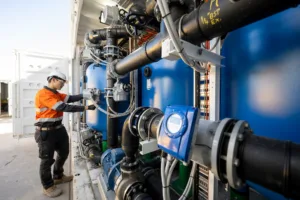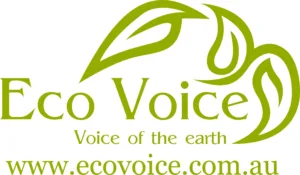Seán Halpin speaks with Tim Langdon, Publisher at Eco-Voice, about the prevalence of per- and polyfluoroalkyl substances (PFAS) in everyday life, the issues related to PFAS contamination, and how our unique technology will help mitigate climate-related water stress by remediating contaminated water to levels safe for discharge back into the environment.

SciDev PFAS Water Treatment Plant
Q1. What is PFAS?
Per- and polyfluoroalkyl substances, PFAS for short, is an umbrella term for a large group of human-made chemicals widely used in various industrial and consumer products around the world since the late 1940s.
Known for their unique non-stick, water- and grease-resistant properties, PFAS are used in everyday consumer products including waterproof clothing, furniture, cookware, electronics, food packaging, firefighting foam and a wide array of industrial processes.
Unfortunately, the properties that make PFAS useful in many applications and particularly in fire-fighting foams, also make them problematic in the environment and for human health.
The biggest problems are that PFAS are persistent (they don’t break down) and bioaccumulate in living organisms. PFAS chemicals have been found in 99% of the humans tested and are known to cause a long list of cancers, birth defects, infertility, thyroid disease and more.
You can be exposed to PFAS from everyday household products, like food packaging, non-stick cookware and stain protection applications for fabrics and carpets. The highest risk of exposure is likely to be through the consumption of contaminated groundwater (i.e. bore water) and food grown using contaminated ground water. Groundwater contamination can persist for decades, posing a serious threat to public health and requiring extensive and costly efforts to clean up and remediate affected water sources.
Sites of PFAS contamination include airports, military bases, mines, fire and rescue stations and other industrial facilities, landfill and waste disposal sites, areas with high firefighting foam usage, communities near manufacturing facilities and agricultural regions.
Q2. Why is PFAS described as a forever chemical?
PFAS chemicals are called ‘forever chemicals’, as they stay forever in the environment and in humans and animals. PFAS are chains of carbon and fluorine atoms held together by some of the strongest chemical bonds in nature. Because of this, they don’t break down naturally, and are difficult to remove.
Q3. How does SciDev clean up PFAS in the environment?
Governments worldwide began recognizing the threat of PFAS contamination in the early 2000s. Over the past 20 years, a range of technologies have been developed to remediate PFAS-contaminated water and soil. But many of these solutions fail to effectively remove PFAS.
Conventional methods like chemical oxidation, thermal treatment, and bioremediation have shown limited success, as removing PFAS contamination is uniquely challenging, time consuming and can be quite costly – the sheer scale of contamination in some areas makes the financial burden significant. The lack of standard regulation around PFAS remediation also creates challenges as it means one site in one part of the world will be remediated according to a different standard to another.
At SciDev, we develop a bespoke solution for every PFAS remediation project we take on. We consider the size of the contaminated area, the molecular make-up of the total PFAS concentration, the presence of co-contaminates, and what we do with the chemical waste generated from removing the PFAS.
Our FluorofIX™ technology can remove all detectible PFAS compounds to below the limits of reporting, allowing treated water to be recycled, reused or discharged directly to the environment while minimising the generation of by‑product wastes.
To date, we have remediated over 30 PFAS‑impacted sites, treating more than seven billion litres of PFAS‑contaminated water across a range of applications to date in Australia. All waters treated have been validated as PFAS-free.
Our FluorofIX™ technology is the most effective, efficient, sustainable, and commercially viable treatment solution available on the market today for addressing the growing PFAS contamination issue in Australia and around the world.
Q4. How big of an issue is PFAS in the environment in Australia?
PFAS contamination is a significant environmental issue in Australia. PFAS compounds have been detected in soil, water bodies, and wildlife, as well as in human populations in various regions across the country. The contamination primarily stems from historical usage of PFAS-containing firefighting foams at military bases, airports, industrial sites, and firefighting training facilities.
In 2016, investigations revealed significant PFAS contamination around Royal Australian Air Force bases such as Williamtown in New South Wales, Tindal in the Northern Territory, and Oakey in Queensland. These incidents highlighted the extent of PFAS pollution and its potential impacts on local communities, ecosystems, and drinking water supplies.
At least 90 sites across Australia are currently under investigation for elevated levels of PFAS near sewage treatment plants, landfills, and places where fire-fighting foams have been used (e.g. mining operations, fuel refineries and storage facilities, airports, fire-training grounds and transport infrastructure).
In response to the growing concern, the Australian government has initiated various measures to address PFAS contamination, including site investigations, risk assessments, and remediation efforts.
Q5. Are there any impacts of SciDev’s technology for climate change?
PFAS contamination no doubt exacerbates the impacts of climate change by reducing the availability of freshwater resources. Climate change is expected to increase water stress in many regions. PFAS contamination further limits freshwater availability by contaminating existing water sources and reducing the suitability of water for various uses.
By remediating contaminated water to levels safe to discharge back into the environment, our technology will help mitigate some climate change impacts by increasing the availability of fresh water sources.
Q6. How can SciDev’s technologies help water-intensive industries more generally?
Our technology and expertise help industry address its most pressing water challenges. Effective water use is part of all business, industry, and community life. Faced with climate change, water scarcity, environmental requirements and tightening operating budgets, industry requires sustainable and cost-effective solutions.
We help industry reduce its consumption of freshwater and generation of wastewater and minimise their environmental footprint by removing harmful contaminants from groundwater, surface water, and industrial liquid waste. We work with companies in the mining and mineral processing, oil and gas, construction and infrastructure, wastewater treatment and environmental remediation industries.
Q7. How can publications, such as Eco Voice, play their part in promoting more efficient water use?
Eco Voice and others can help promote sustainability in water intensive industries by featuring articles, case studies, and interviews that highlight innovative and sustainable technologies, practices, and projects.
Providing a platform for thought leaders, industry experts, and companies like SciDev to share insights and success stories can inspire and educate readers about the importance of sustainability in the business sector.
About Eco Voice
First published in 2003, Eco Voice is your go-to publication for sustainability news in Australia. Eco Voice prides itself as an independent news platform with a clear focus on sustainability, with articles coming from a diverse range of contributors – all levels of government, corporations, not-for-profits, community groups, small to medium sized businesses, universities, research organisations, together with input from international sources. Eco Voice values community, conservation and commerce. Eco Voice is a media partner of the prestigious Australian Banksia Sustainability Awards – The Peak Sustainability Award

